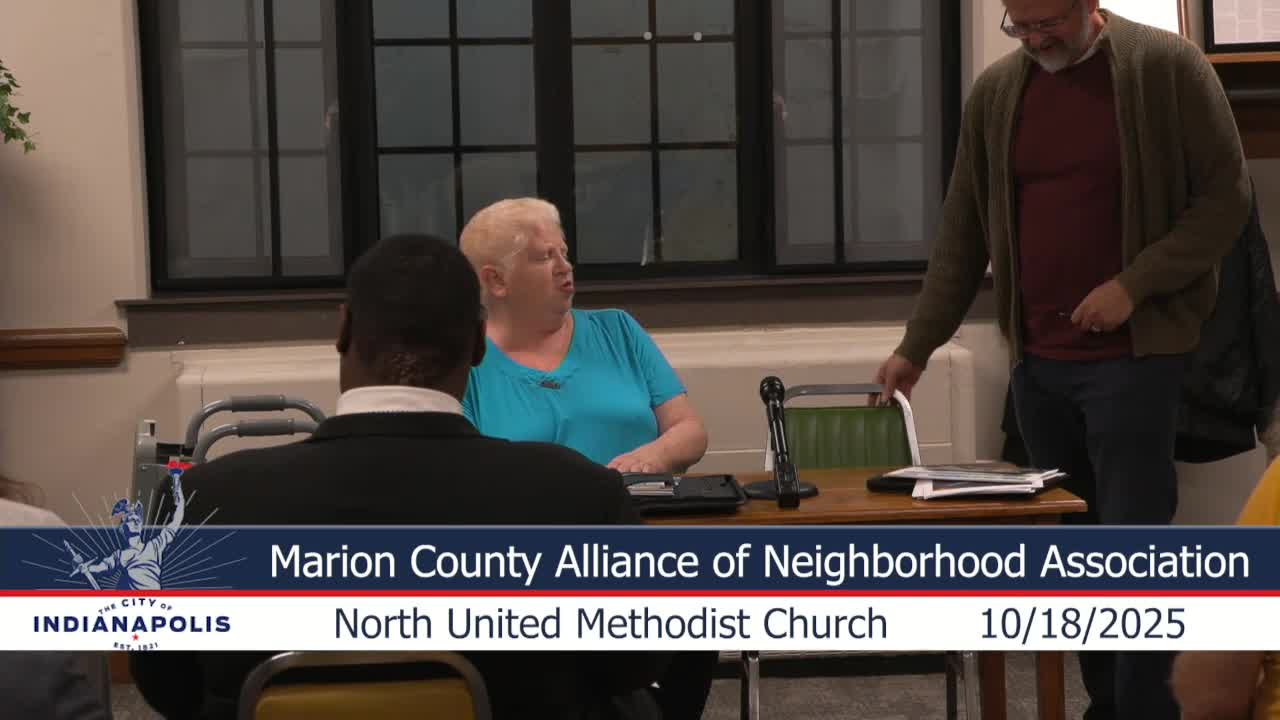Hoosier Environmental Council urges neighborhoods to protect wetlands, questions data‑center impacts
October 20, 2025 | Indianapolis City, Marion County, Indiana
This article was created by AI summarizing key points discussed. AI makes mistakes, so for full details and context, please refer to the video of the full meeting. Please report any errors so we can fix them. Report an error »

Sam Carpenter, executive director of the Hoosier Environmental Council, told a neighborhood meeting that Marion County communities face steadily shrinking wetlands and that residents should press for transparency when large projects such as data centers are proposed.
Carpenter described wetlands as “critical, natural infrastructure” that act as sponges to reduce flooding, purify water and recharge aquifers. He said Indiana has “lost about 90% of our regional wetlands in the state,” and urged communities to identify and organize around areas they want preserved.
Why this matters: wetlands and urban green space provide flood protection, water‑quality benefits and habitat; development decisions that allow wetland filling or heavy industrial uses can shift flood and pollution risks onto neighboring communities.
Data centers, energy and local leverage
Carpenter said data centers consume large amounts of electricity and sometimes water for cooling, and that their local impacts can exceed perceived local benefits. He noted policy incentives and tax abatements can attract data centers but that communities should insist on transparent information during rezoning so they can evaluate electricity demand, water use, diesel backup generation and other local impacts. Carpenter said communities have leverage at the rezoning stage because operators “know what their anticipated electricity use is” and that those details should be available to negotiating jurisdictions.
Local environment, water and air quality
Carpenter discussed the White River and the recently completed big‑dig stormwater investment; he said nature‑based solutions and reduced fertilizer use can complement large infrastructure projects. On air quality, Carpenter said coal plants and transportation remain contributors to pollution and that clean, affordable renewable energy and electrified transport are part of long‑term solutions.
Hoosier Environmental Council resources
Carpenter described HEC as a statewide nonprofit with staff capacity to supply data, technical assistance and policy guidance. He offered two resources at the meeting—a community guide for data‑center questions and a policy guide for local officials—and provided contact information (email scarpenter@hecweb.org; office (317) 685‑8800). He also said HEC pursues advocacy, education and, when necessary, legal action; Carpenter referenced a current legal challenge in Martinsville involving contaminated discharge to the White River.
Community questions and local monitoring
Marion County Public Health staff at the meeting said they have monitored ambient water in Fall Creek, the White River and other waterways and have seen localized reductions in E. coli in some spots; staff said they will continue multi‑year monitoring to assess water‑quality trends.
Ending: Carpenter urged neighborhoods to use HEC as a resource for data and organizing and to press for transparency and concrete mitigation measures during rezoning and project review.
Carpenter described wetlands as “critical, natural infrastructure” that act as sponges to reduce flooding, purify water and recharge aquifers. He said Indiana has “lost about 90% of our regional wetlands in the state,” and urged communities to identify and organize around areas they want preserved.
Why this matters: wetlands and urban green space provide flood protection, water‑quality benefits and habitat; development decisions that allow wetland filling or heavy industrial uses can shift flood and pollution risks onto neighboring communities.
Data centers, energy and local leverage
Carpenter said data centers consume large amounts of electricity and sometimes water for cooling, and that their local impacts can exceed perceived local benefits. He noted policy incentives and tax abatements can attract data centers but that communities should insist on transparent information during rezoning so they can evaluate electricity demand, water use, diesel backup generation and other local impacts. Carpenter said communities have leverage at the rezoning stage because operators “know what their anticipated electricity use is” and that those details should be available to negotiating jurisdictions.
Local environment, water and air quality
Carpenter discussed the White River and the recently completed big‑dig stormwater investment; he said nature‑based solutions and reduced fertilizer use can complement large infrastructure projects. On air quality, Carpenter said coal plants and transportation remain contributors to pollution and that clean, affordable renewable energy and electrified transport are part of long‑term solutions.
Hoosier Environmental Council resources
Carpenter described HEC as a statewide nonprofit with staff capacity to supply data, technical assistance and policy guidance. He offered two resources at the meeting—a community guide for data‑center questions and a policy guide for local officials—and provided contact information (email scarpenter@hecweb.org; office (317) 685‑8800). He also said HEC pursues advocacy, education and, when necessary, legal action; Carpenter referenced a current legal challenge in Martinsville involving contaminated discharge to the White River.
Community questions and local monitoring
Marion County Public Health staff at the meeting said they have monitored ambient water in Fall Creek, the White River and other waterways and have seen localized reductions in E. coli in some spots; staff said they will continue multi‑year monitoring to assess water‑quality trends.
Ending: Carpenter urged neighborhoods to use HEC as a resource for data and organizing and to press for transparency and concrete mitigation measures during rezoning and project review.
Don't Miss a Word: See the Full Meeting!
Go beyond summaries. Unlock every video, transcript, and key insight with a Founder Membership.
✓
Get instant access to full meeting videos
✓
Search and clip any phrase from complete transcripts
✓
Receive AI-powered summaries & custom alerts
✓
Enjoy lifetime, unrestricted access to government data
30-day money-back guarantee

